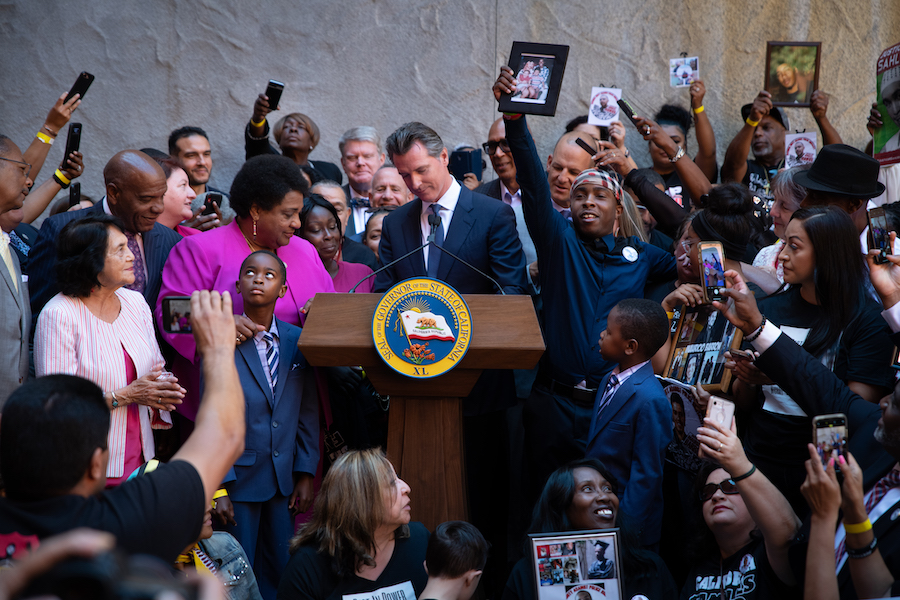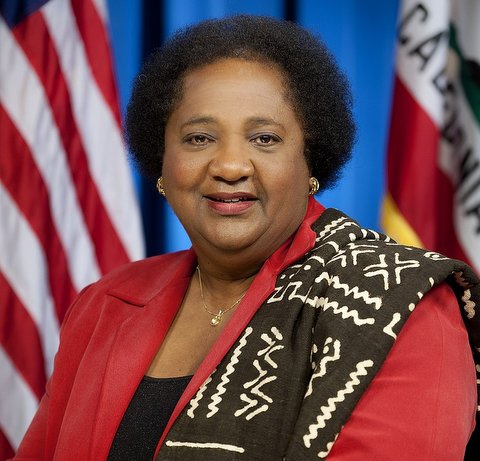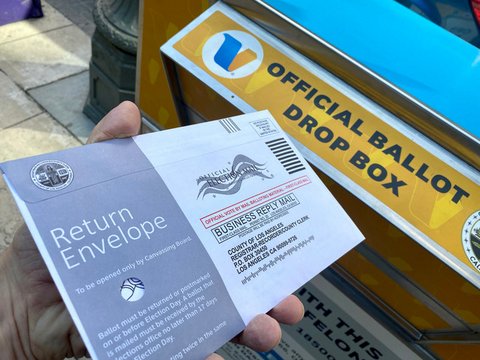
10 Sep From ‘Reasonable’ to ‘Necessary’: California’s New Use of Force Laws Explained

Above: Governor Gavin Newsom signs AB 392 “California Act to Save Lives” with family members and advocates standing by his side along with the author Assemblymember, Dr. Shirley Weber (D-San Diego) and legislative leaders August 19, 2019. Photo via California Black Media
Interview, Dr. Joseph Marshall
Editor’s Note: California now has one of the strongest police use-of-force laws in the country. Signed by Gov. Gavin Newsom on Aug. 19, the California Act to Save Lives is intended to deter police officers from killing civilians while pursuing criminal suspects.
Dr. Joseph Marshall, host of Street Soldiers Radio on 106 KMEL, interviewed San Francisco Police Chief William Scott about the new law. The following is a transcript of that conversation which aired on Aug. 25. It has been condensed and edited for clarity.
Dr. Joseph Marshall: After a year-long process, the California Senate voted 29-1 to pass Assembly Bill 392. It requires officers to only use deadly force “in defense of human life” when a suspect poses an “imminent threat or serious bodily injury to themselves or others.” The bill also calls for officers to rely on training and exhaust all other resources available to them before shooting to kill.
For years, there have been cases many people felt shouldn’t have been ruled justifiable homicides based on the nature of the shooting, including those involving unarmed folks. The good thing about this is that it covers all of the departments in the state. There is some nuance in here.
Chief Scott, can you take us through what this means for your department and all the departments in California?
Chief William Scott: AB392 does two major things. As far as the penal code, it amends Section B 196 that deals with justifiable homicides in the realm of police officers. It says when a homicide results from a peace officer’s use of force, that is compliant with Section 835A, which really deals with police officer’s authority to use physical force. The changes with AB 392 spell out that force must be necessary and that’s a huge change in terms of changing the culture of policing in California. I think that’s what this was designed to do.
Graham vs. Connor established the federal legal standard: objectively reasonable. Reasonable is still a factor, but the word necessary is a big change.
Now what that really means is you can only use deadly force when necessary. Although some might say that’s a subtle change in wording, it’s really not because it really changes the game in terms of raising that standard from objectively reasonable to necessary. And that’s a really big shift.
When you look at the San Francisco Police Department’s use of force policy, which was changed at the end of 2016, it already refers to the language “necessary” in many sections. So, it was really a game changer for us and what we’ve seen since that was introduced is that our use of force has steadily gone down. We’ve had a long streak, over 15 months I believe, since we’ve had an officer-involved shooting. So the spirit of the law is already in our policy.
JM: There are a couple other things here. The bill now lets investigators and prosecutors consider the totality of circumstances. In my mind, that looks at the total picture of what’s going on, rather than just the immediate moment. The other thing this bill allows is the behavior of the suspect to be examined, what’s possibly going on with them. I don’t even think the suspect was considered a lot of times in cases before.
While I know some folks feel this didn’t go far enough, what is the process for getting officers to now make this a part of the way they do things?
WS: Training is a big part of any process in terms of changing the narrative on use of force. In San Francisco, we emphasize de-escalation now in our policy and our crisis intervention training has been ongoing for many years. Those things are paying real dividends.
‘Totality of circumstances’ is defined in this amended law by all the facts known to the police officer, including the conduct of the officer and the subject leading up to the use of deadly force. In reference to use of force, we can’t really use hindsight to evaluate whether or not force is justified or reasonable.
It’s easy to see everything in hindsight. Those situations often times are very quick, volatile and things are coming at the officers quickly. You have to look at what they knew at the time. Then you make a judgment on whether that force was necessary. I do believe that is a fair process if we are able to do that.
I think we all want fairness on the behalf of everyone involved.
JM: Maybe the best thing about this is that they got the buy-in from the police unions. A lot of them were concerned that this would make it tough for officers to do their jobs, but Gov. Newsom pulled everyone in the room and they worked it out.
I also have to give credit to Black Lives Matter, one of the first groups to support this legislation, though it did not go as far as they would have liked. (Black Lives Matter withdrew support for AB 392 after amendments to the bill were made)
Bottom line is, if folks don’t get shot, that is what is we want.
Thanks, Chief.





No Comments